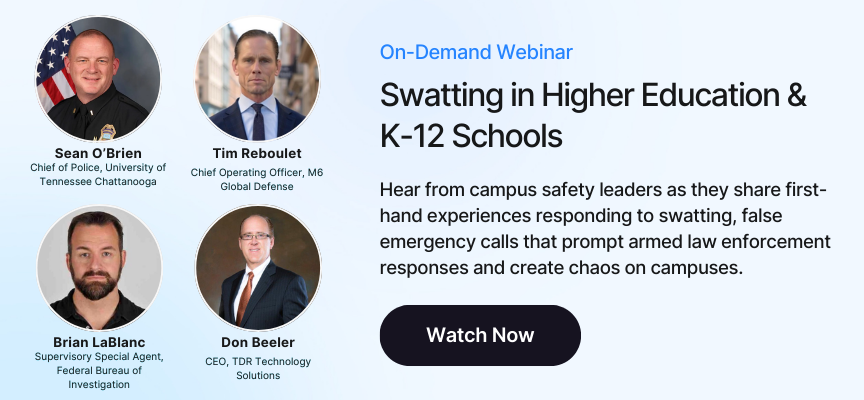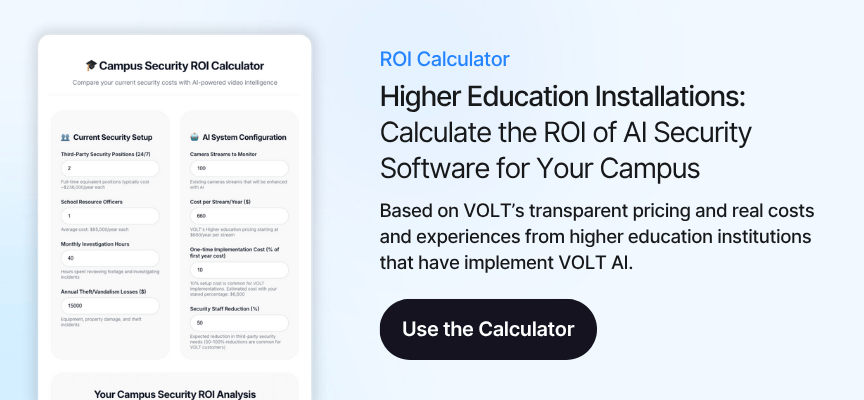Key Points
- AI-powered video intelligence provides critical negative evidence during swatting incidents: When VOLT AI doesn't detect threats in reported locations, this absence of alerts serves as valuable intelligence for threat assessment
- The "tactical pause" concept improves response quality to swatting calls: Technology enables security teams to take seconds for critical analysis before escalating responses, reducing unnecessary evacuations and trauma from false active shooter reports
- Situational awareness tools help distinguish real threats from swatting hoaxes: AI systems monitor multiple data points simultaneously, giving decision-makers comprehensive context within moments during emergency calls
- Technology supports, not replaces, human judgment in swatting scenarios: AI threat verification systems provide security teams with actionable intelligence to make faster, more informed decisions when responding to hoax calls
- Swatting incidents cost more than money: Beyond the financial impact estimated at over $1 billion to taxpayers in recent years, false threats create lasting mental health effects and erode trust in school safety systems
What Is a Swatting Incident? Understanding Modern Threat Landscapes
The phone rings. A dispatcher hears gunfire sounds and a voice claiming someone is shooting in your school library. Within seconds, that call sets dozens of decisions in motion. Officers respond at high speed. Parents receive emergency alerts. Students shelter in place. The entire apparatus of emergency response activates instantly.
What if technology could help you pause and verify before that cascade begins?
A swatting incident occurs when someone makes a false report of a serious emergency — such as an active shooter, bomb threat, or hostage situation — to trigger a large-scale law enforcement response, often involving SWAT teams. These hoax calls exploit fears and emergency protocols, creating chaos while wasting critical public safety resources. According to the FBI, over 5,000 swatting incidents occur annually across the United States, with schools representing frequent targets.
When Every Second Counts: The Reality of School Swatting Threats
School safety leaders face an impossible tension. Hesitate for even a moment during a real emergency, and the consequences could be catastrophic. React too quickly to a swatting hoax, and you expose students to different but equally serious risks—from officers responding at dangerous speeds to the mental health trauma of repeated false alarms.
The University of Tennessee experienced this tension firsthand during their Welcome Week in August. Their 911 center received a call on the administrative line reporting an active shooter in the library, complete with AI-generated gunfire sounds in the background. The call had every hallmark of a swatting incident: non-emergency line, single caller, vague details.
Yet within minutes, multiple agencies responded. Buildings were evacuated. The campus mobilized for what appeared to be a crisis.
But one piece of technology provided crucial intelligence that traditional security systems couldn't: negative evidence.
The Power of Negative Evidence: What AI Didn't Detect During the Swatting Call
UTC Police Chief Sean O'Brien had deployed VOLT AI's weapon detection system in the area where the threat was supposedly occurring. As the 911 call came in and officers began responding, Chief O'Brien noticed something significant: silence from the AI system.
“Most people didn't know this, but we have AI technology on our cameras in the area where this supposedly was occurring. I knew right away that we weren't getting any alerts until officers showed up. That was a useful piece of information for me as I got to the command post in terms of assessing what our next steps were going to be.”
Sean O'Brien
UTC Police Chief
This absence of detection, what security professionals call negative evidence, provided critical intelligence. VOLT AI continuously monitors camera feeds for weapons, even partially concealed ones. The system didn't detect any weapons in the reported location. This didn't eliminate all risk, but it gave the command team valuable context for their tactical decisions.
The concept transforms how schools can approach threat verification during swatting incidents. Traditional security systems only provide information when something happens. AI-powered systems like VOLT AI provide continuous monitoring, meaning the absence of alerts carries meaning. That negative evidence becomes a data point security teams can use to distinguish false active shooter reports from real emergencies.
Building Situational Awareness Through AI Technology During Swatting Incidents
AI-powered security systems fundamentally change the information available during those critical first minutes of a potential threat or swatting call. Traditional approaches rely heavily on the initial 911 call and whatever visual confirmation responding officers can provide. This creates information gaps that force decision-makers to operate with incomplete intelligence during hoax emergencies.
Modern AI systems fill those gaps with multiple data streams that work together to create comprehensive situational awareness:
- 3D facility mapping: Shows exactly where cameras are positioned, what they can see, and where coverage gaps exist in real-time
- Real-time video analytics: Monitors continuously for specific threat indicators including weapons, unusual crowd formations, and people in distress
- Instant intelligence delivery: Provides information to security teams immediately rather than hours later during forensic investigation
- Multi-camera coordination: Tracks individuals and situations across different camera feeds to maintain comprehensive visibility
- Behavioral pattern recognition: Identifies anomalous activities that may indicate developing threats before they escalate
The difference shows up in response quality to swatting incidents. At UTC, even though the initial call triggered a full response, the command team could assess the situation more accurately. They knew which areas had been actively monitored. They understood what the technology had and hadn't detected. This situational awareness enabled them to make more informed decisions as the incident unfolded.
Chief O'Brien emphasizes this point: "We were able at the command post to slow things down very quickly and just be very methodical, and we're pushing out updated messages to our campus community."
That ability to "slow things down" while still maintaining appropriate vigilance represents a fundamental shift in how schools can respond to swatting threats.
The Tactical Pause: How Technology Enables Better Decision-Making During Swatting Calls
Tim Ruble, COO of M6 Global Defense and former law enforcement officer, teaches the concept of a "tactical pause" to dispatchers and security teams responding to potential swatting incidents. The idea is simple but powerful: take a breath, assess the available information, then decide how to respond.
"Instead of making a decision based on emotion, you need to use your frontal cortex," Ruble explains. He teaches dispatchers to use the OODA loop: observe, orientate, decide, and act.
The challenge is that taking even a few seconds to think feels impossible when you believe lives are at stake during a swatting call. This is where technology becomes crucial, it provides the information needed to make that tactical pause valuable rather than dangerous.
Consider how the response changes when security teams have access to AI-powered intelligence during a swatting incident:
Traditional Response to Swatting | AI-Enhanced Response to Swatting |
Single information source: Initial 911 call provides all available intelligence | Multiple data streams: 911 call plus real-time AI monitoring, camera analytics, and facility mapping |
Binary decision: React fully or not at all to the hoax call | Graduated response: Scale response based on confirmed threat indicators |
Post-incident verification: Technology used only for forensic analysis | Real-time verification: AI provides continuous threat assessment as swatting situation develops |
Information scarcity: Decision-makers operate with limited data | Information abundance: Security teams have comprehensive situational awareness |
Static assessment: Initial evaluation drives all subsequent decisions | Dynamic assessment: New intelligence continuously informs response strategy |
The tactical pause doesn't mean delaying response to real threats. It means using those critical first seconds to gather the intelligence that distinguishes real emergencies from sophisticated swatting hoaxes. When dispatchers and security teams can see what AI systems are detecting (or not detecting) in real-time, they can make that assessment quickly and confidently.
FBI Supervisory Special Agent Brian Leblanc, who trains law enforcement on swatting threats, emphasizes that hoax calls have distinctive characteristics:
- Non-emergency line usage: Swatting calls typically come through administrative lines rather than 911 direct
- Single caller scenario: Real incidents generate floods of reports, while hoaxes come from one source
- Lack of specific details: Hoax callers provide vague information that can't be easily verified
- Unusual threat warnings: No actual active shooter has ever called ahead to warn their target location
- Inconsistent behavioral patterns: The caller's demeanor or story doesn't match genuine emergency situations
AI systems can help security teams verify these indicators rapidly during a swatting incident. Is this the only report? Are cameras in that location showing normal activity? Are other threat indicators present or absent?
These questions can be answered in seconds rather than minutes when the right technology is in place.
Implementing Technology-Assisted Verification for Swatting Incidents
Schools ready to enhance their swatting incident verification capabilities should consider several key factors when evaluating AI-powered security systems. The technology must integrate seamlessly with existing camera infrastructure—replacing an entire surveillance system is neither practical nor necessary for most institutions.
VOLT AI works with existing IP cameras, allowing schools to add intelligence to infrastructure they've already invested in. The system provides both cloud-based and on-premises deployment options, giving schools flexibility based on their technical requirements and resources.
Critical capabilities for swatting threat verification include:
- Real-time weapon detection: Identifies firearms and other weapons even when partially concealed, providing immediate alerts when threats are present
- Continuous monitoring: 100% camera coverage ensures that the absence of alerts carries meaningful intelligence value for threat assessment during swatting calls
- 3D facility mapping: Security teams need spatial awareness showing exactly what cameras can see and where blind spots exist
- Immediate alert routing: Notifications must reach the right decision-makers within seconds through multiple communication channels including mobile devices
- Privacy-conscious operation: Monitors behaviors and threats without relying on facial recognition, addressing privacy concerns while maintaining security effectiveness
- Integration capabilities: Works with existing security infrastructure, from access control to emergency notification systems
The implementation process matters as much as the technology itself. Schools should work with vendors who understand the education environment and can customize the system for their specific campus layout and security protocols.
Essential implementation considerations for swatting incident response include:
- Comprehensive training programs: Security teams, administrators, and dispatchers all need to understand what the AI system can and cannot detect during hoax emergencies
- Alert interpretation protocols: Teams must know how to factor both the presence and absence of alerts into swatting threat assessment processes
- Communication channel establishment: Clear escalation paths ensure the right people receive intelligence at the right time
- Integration testing: Verify that AI systems work seamlessly with existing emergency response procedures before swatting incidents occur
- Regular system evaluation: Ongoing assessment ensures the technology continues to meet evolving security needs
UTC's experience demonstrates the value of this preparation. When their swatting incident occurred, Chief O'Brien immediately understood what the lack of VOLT AI alerts meant. That instant recognition came from familiarity with the system's capabilities and limitations, knowledge that proved invaluable during the actual incident.
How Much Do Swatting Incidents Cost? Understanding the Financial and Human Impact
The swatting threat landscape continues to evolve. According to FBI estimates, over 5,000 swatting incidents occur annually across the United States, with schools representing frequent targets. These aren't just American problems—the FBI has provided training to multiple countries dealing with similar threats.
The financial costs are staggering. Based on analysis by TDR Technology Solutions, swatting incidents have cost taxpayers over $1 billion in the last two years when accounting for lost instructional time, mental health impacts, and emergency response expenses. A single swatting call lasting one hour can cost a medium-sized school district hundreds of thousands of dollars.
But the deeper costs — trauma to students, erosion of trust in school safety systems, and the mental health burden on entire communities — defy simple calculation. Every false active shooter report that triggers a full emergency response creates lasting impacts. Students who experience multiple swatting threats during a school year face significantly higher rates of anxiety and academic disruption.
AI Technology: A New Standard for Swatting Incident Response
Technology can't prevent all swatting threats. But it can dramatically improve how schools assess and respond to them. AI-powered video intelligence provides the situational awareness that security teams need to distinguish real emergencies from sophisticated swatting hoaxes. It enables the tactical pause that allows for better decision-making. It offers both positive detection of threats and the negative evidence when threats aren't present during hoax calls.
Schools that implement these systems report significant improvements in their response capabilities to swatting incidents. They can scale their reactions appropriately. They avoid unnecessary evacuations when threats aren't credible. They maintain better campus communication because they have better intelligence to share.
Perhaps most importantly, they give their security teams the confidence to make difficult decisions under pressure. When Chief O'Brien noted the absence of VOLT AI alerts during UTC's swatting incident, that wasn't the only factor in his assessment. But it was a critical piece of intelligence that traditional security systems couldn't provide. Combined with other threat indicators, it helped his team make informed decisions that ultimately kept their campus safe.
The goal isn't to replace human judgment with algorithms during swatting calls. The goal is to provide human decision-makers with the best possible intelligence when seconds matter most. In an era when sophisticated hoaxes can mimic real threats with alarming accuracy, that intelligence becomes essential.
Technology can help verify swatting threats in real-time. It can provide the negative evidence that's just as valuable as positive detection. It can enable security teams to take that crucial tactical pause without compromising safety. For schools facing an ever-evolving threat landscape, these capabilities aren't luxuries; they're necessities for protecting both physical safety and community wellbeing.






